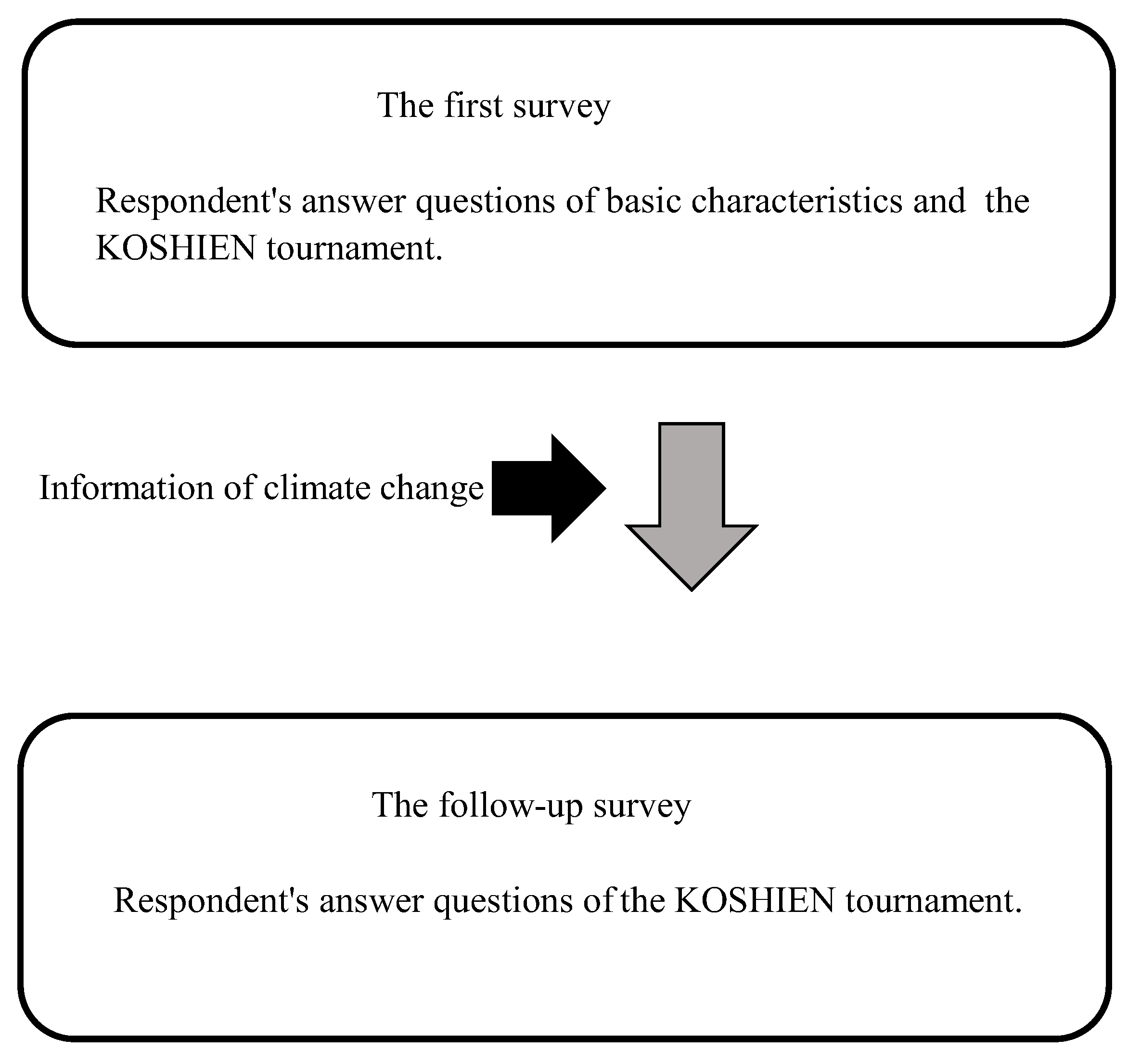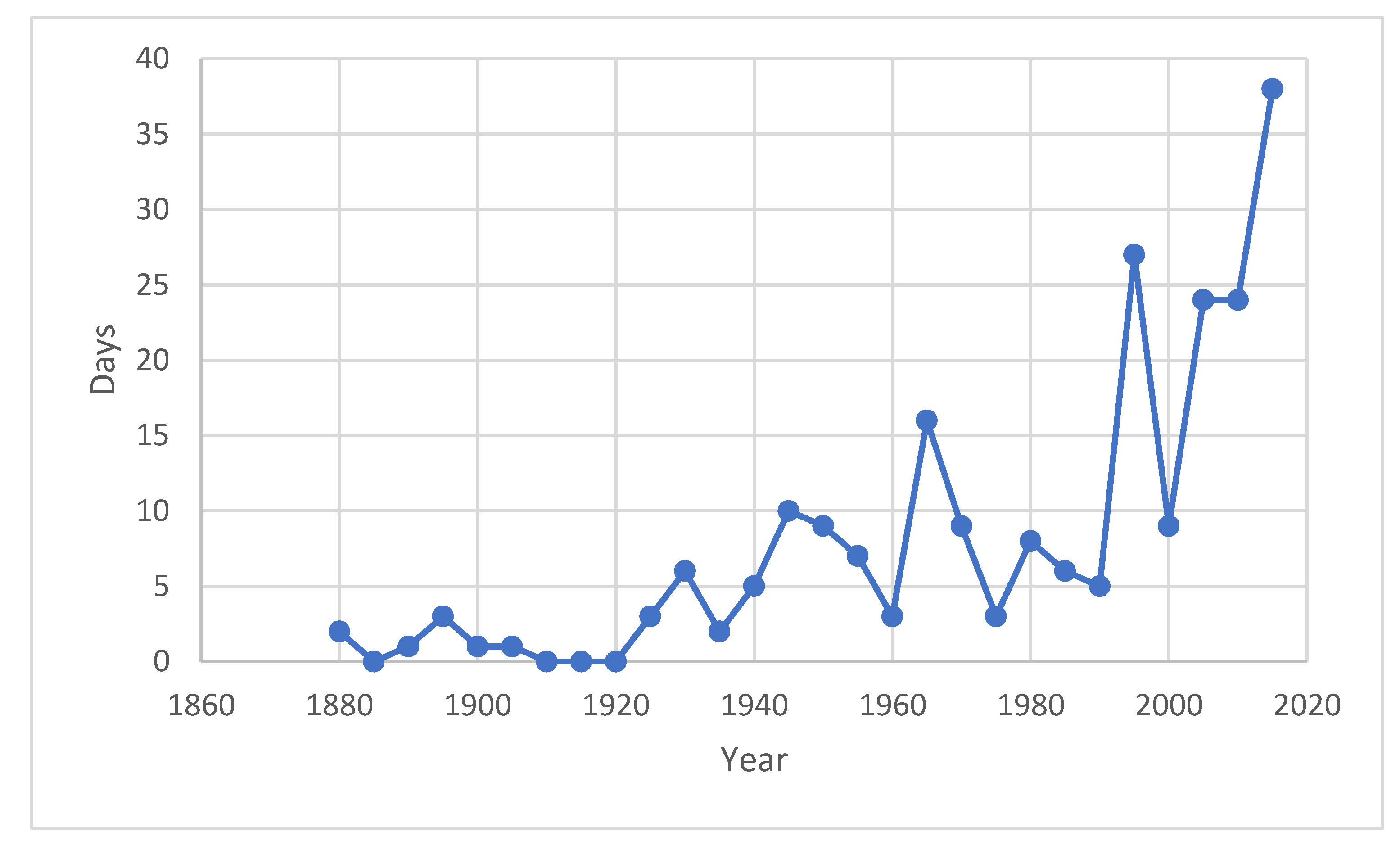Fierce Heat and Players’ Health: Examining the View on Japan High School Baseball
Abstract
:1. Introduction
2. Methods and Data
2.1. Experimental Design
2.1.1. First Survey
Do you agree that the operation system of the tournament should be changed to protect the school player’s health?
1 (Strongly disagree) to 5 (Strongly agree).
2.1.2. Follow-Up Survey
2.2. Data
2.3. Method
3. Results
4. Discussion
5. Conclusions
Funding
Institutional Review Board Statement
Informed Consent Statement
Data Availability Statement
Acknowledgments
Conflicts of Interest
References
- Campbell, S.; Remenyi, T.A.; White, C.J.; Johnston, F.H. Heatwave and health impact research: A global review. Health Place 2018, 53, 210–218. [Google Scholar] [CrossRef] [PubMed]
- Sugg, M.M.; Konrad, C.E.; Fuhrmann, C.M. Relationships between maximum temperature and heat-related illness across North Carolina, USA. Int. J. Biometeorol. 2016, 60, 663–675. [Google Scholar] [CrossRef] [PubMed]
- Sung, T.-I.; Wu, P.-C.; Lung, S.-C.; Lin, C.-Y.; Chen, M.-J.; Su, H.-J. Relationship between heat index and mortality of 6 major cities in Taiwan. Sci. Total Environ. 2013, 442, 275–281. [Google Scholar] [CrossRef] [PubMed]
- Yin, Q.; Wang, J. The association between consecutive days’ heat wave and cardiovascular disease mortality in Beijing, China. BMC Public Health 2017, 17, 223. [Google Scholar] [CrossRef] [Green Version]
- Zeng, Q.; Li, G.; Cui, Y.; Jiang, G.; Pan, X. Estimating temperature-mortality exposure-response relationships and optimum ambient temperature at the multi-city level of China. Int. J. Environ. Res. Public Health 2016, 13, 279. [Google Scholar] [CrossRef] [Green Version]
- Ward, K.; Lauf, S.; Kleinschmit, B.; Endlicher, W. Heat waves and urban heat islands in Europe: A review of relevant drivers. Sci. Total Environ. 2016, 569–570, 527–539. [Google Scholar] [CrossRef]
- Tan, J.; Zheng, Y.; Tang, X.; Guo, C.; Li, L.; Song, G.; Zhen, X.; Yuan, D.; Kalkstein, A.J.; Li, F.; et al. The urban heat island and its impact on heat waves and human health in Shanghai. Int. J. Biometeorol. 2010, 54, 75–84. [Google Scholar] [CrossRef]
- Turner, L.R.; Connell, D.; Tong, S. The Effect of Heat Waves on Ambulance Attendances in Brisbane, Australia. Prehospital Disaster Med. 2013, 28, 482–487. [Google Scholar] [CrossRef] [Green Version]
- Phung, D.; Chu, C.; Rutherford, S.; Nguyen, H.L.T.; Do, C.M.; Huang, C. Heatwave and risk of hospitalization: A multi-province study in Vietnam. Environ. Pollut. 2017, 220, 597–607. [Google Scholar] [CrossRef]
- Isaksen, T.B.; Fenske, R.A.; Hom, E.K.; Ren, Y.; Lyons, H.; Yost, M.G. Increased mortality associated with extreme-heat exposure in King County, Washington, 1980–2010. Int. J. Biometeorol. 2016, 60, 85–98. [Google Scholar] [CrossRef] [Green Version]
- Kyodo News. 11 dead, 5600 people sent to hospitals in Japan heatwave. Kyodo News. 30 July 2019. Available online: https://english.kyodonews.net/news/2019/07/2c0b97e13870-11-dead-5600-people-sent-to-hospitals-in-japan-heatwave.html (accessed on 10 December 2021).
- Ando, I.; Takeuchi, A.; Araki, S. Japan heatstroke death toll hits 162; lack of air conditioning cited. Mainichi Newspaper. 10 August 2019. Available online: https://mainichi.jp/english/articles/20190810/p2a/00m/0na/013000c (accessed on 10 December 2021).
- Durkee, A. Tokyo Olympics: Tennis shifts later due to extreme heat after player Medvedev says he ‘can die’ during match. Forbs. 28 July 2021. Available online: https://www.forbes.com/sites/alisondurkee/2021/07/28/tokyo-olympics-tennis-shifts-later-due-to-extreme-heat-after-player-medvedev-says-he-can-die-during-match/?sh=763ae92a162b (accessed on 10 December 2021).
- Smith, K.R.; Woodward, A.; Lemke, B.; Otto, M.; Chang, C.J.; A Mance, A.; Balmes, J.; Kjellstrom, T. The last Summer Olympics? Climate change, health, and work outdoors. Lancet 2016, 388, 642–644. [Google Scholar] [CrossRef]
- Yomiuri Newspaper. Fans at Koshien finding ways to beat the heat Baseball Federation of Japan. Yomiuri Newspaper. 12 August 2019. Available online: https://baseballjapan.org/system/prog/news.php?l=e&i=1802 (accessed on 10 December 2021).
- Rich, M.; Ueno, H.; Inoue, M. In Japan, Deadly Heat Wave Tests Endurance of Even the Most Stoic. New York Times (Online). 25 July 2018. Available online: https://www.nytimes.com/2018/07/25/world/asia/japan-heat-wave.html (accessed on 10 December 2021).
- Yamamura, E. Identity, nostalgia and happiness among migrants: The case of the Kōshien High School Baseball Tournament in Japan. Pac. Econ. Rev. 2017, 22, 792–813. [Google Scholar] [CrossRef]
- Whiting, R. Agony and ecstasy: Why Japan is obsessed with high school baseball. Nikkei Asia. 24 July 2019. Available online: https://asia.nikkei.com/Life-Arts/Life/Agony-and-ecstasy-Why-Japan-is-obsessed-with-high-school-baseball (accessed on 10 December 2021).
- Lefton, B. In Japan, 100 Years of Glory Days for High School Baseball. New York Times (Online). 16 August 2018. Available online: https://www.nytimes.com/2018/08/16/sports/japan-high-school-baseball.html (accessed on 10 December 2021).
- Arai, R.; Fujita, T.; Yasuda, M. Japan Koshien HS ballplayers using white spikes to counter heat in substitute event. Mainichi Newspaper. 14 August 2020. Available online: https://mainichi.jp/english/articles/20200813/p2a/00m/0na/015000c#:~:text=Japan%20Koshien%20HS%20ballplayers%20using%20white%20spikes%20to%20counter%20heat%20in%20substitute%20event,-August%2014%2C%202020&text=OSAKA%20%2D%2D%20Japan%20high%20school,championship%20that%20began%20on%20Aug (accessed on 10 December 2021).
- Yomiuri Newspaper. Editorial: Use tiebreakers as 1st step to ease burden on high school baseball players. Yomiuri Newspaper. 25 September 2017. Available online: https://www.staradvertiser.com/2017/11/09/news/use-tiebreakers-as-1st-step-to-ease-burden-on-high-school-baseball-players/ (accessed on 10 December 2021).
- Orlov, A.; Sillmann, J.; Aaheim, A.; Aunanm, K.; Bruin, K. Economic Losses of Heat-Induced Reductions in Outdoor Worker Productivity: A Case Study of Europe. Econ. Disasters Clim. Change 2019, 3, 191–211. [Google Scholar] [CrossRef]
- Das, S. Television Is More Effective in Bringing Behavioral Change: Evidence from Heat-Wave Awareness Campaign in India. World Dev. 2016, 88, 107–121. [Google Scholar] [CrossRef]
- Rey, G.; Fouillet, A.; Jougla, E.; Hemon, D. Heat Waves, Ordinary Temperature Fluctuations and Mortality in France since 1971. Population 2007, 62, 457–485. [Google Scholar] [CrossRef]
- Hota, P.; Behera, B. Understanding the Household Perceptions of and Adaptations to Heat Wave: A Case Study. Int. J. Ecol. Econ. Stat. 2014, 33, 98–117. [Google Scholar]
- Zaidi, R.Z.; Pelling, M. Institutionally Configured Risk: Assessing Urban Resilience and Disaster Risk Reduction to Heat Wave Risk in London. Urban Stud. 2015, 52, 1218–1233. [Google Scholar] [CrossRef]
- Das, S.; Smith, S.C. Awareness as an Adaptation Strategy for Reducing Mortality from Heat Waves: Evidence from a Disaster Risk Management Program in India. Clim. Change Econ. 2012, 3, 1250010. [Google Scholar] [CrossRef]
- Pechan, A.; Eisenack, K. The impact of heat waves on electricity spot markets. Energy Econ. 2014, 43, 63–71. [Google Scholar] [CrossRef] [Green Version]
- Somanathan, E.; Somanathan, R.; Sudarshan, A.; Tewari, M. The Impact of Temperature on Productivity and Labor Supply: Evidence from Indian Manufacturing. J. Political Econ. 2021, 129, 1797–1827. [Google Scholar] [CrossRef]
- Cai, X.; Lu, Y.; Wang, J. The impact of temperature on manufacturing worker productivity: Evidence from personnel data. J. Comp. Econ. 2018, 46, 889–905. [Google Scholar] [CrossRef]
- Haaland, I.; Roth, C.; Wohlfart, J. Designing Information Provision Experiments. J. Econ. Lit. (Forthcom.). Available online: www.RePEc.org (accessed on 10 December 2021).
- Dupas, P. Do teenagers respond to HIV risk information? Evidence from a field experiment in Kenya. Am. Econ. J. Appl. Econ. 2011, 3, 1–34. [Google Scholar] [CrossRef] [Green Version]
- Bennear, L.; Tarozzi, A.; Pfaff, A.; Balasubramanya, S.; Ahmed, K.M.; van Geen, A. Impact of a randomized controlled trial in arsenic risk communication on household water-source choices in Bangladesh. J. Environ. Econ. Manag. 2013, 65, 225–240. [Google Scholar] [CrossRef] [Green Version]
- Allcott, H.; Knittel, C. Are consumers poorly informed about fuel economy? Evidence from two experiments. Am. Econ. J. Econ. Policy 2019, 11, 236–276. Available online: https://www.aeaweb.org/articles?id=10.1257/app.20170328 (accessed on 10 December 2021). [CrossRef] [Green Version]
- Allcott, H. Social norms and energy conservation. J. Public Econ. 2011, 95, 1082–1095. Available online: https://mail.google.com/mail/u/0/?tab=wm&ogbl#inbox (accessed on 10 December 2021). [CrossRef] [Green Version]
- Fetzer, T.; Hensel, L.; Hermle, J.; Roth, C. Coronavirus Perceptions and Economic Anxiety. Rev. Econ. Stat. 2020, 103, 968–978. [Google Scholar] [CrossRef]
- Peterson, E.; Iyengar, S. Partisan Gaps in Political Information and Information-Seeking Behavior: Motivated Reasoning or Cheerleading? Am. J. Political Sci. 2021, 65, 133–147. [Google Scholar] [CrossRef]
- Yamamura, E.; Tsutsui, Y. Trade policy preference, childhood sporting experience, and informal school curriculum: An examination of views of the TPP from the viewpoint of behavioral economics. Rev. Int. Econ. 2019, 27, 61–90. [Google Scholar] [CrossRef] [Green Version]
- Yamamura, E.; Managi, S.; Tsutsui, Y. Male pupils taught by female homeroom teachers show a higher preference for Corporate Social Responsibility in adulthood. J. Jpn. Int. Econ. 2019, 54, 101048. [Google Scholar] [CrossRef] [Green Version]
- Clark, A.; Senik, C.; Yamada, K. The Joneses in Japan: Income comparisons and financial satisfaction. Jpn. Econ. Rev. 2020. [Google Scholar] [CrossRef] [Green Version]
- Barber, B.M.; Odean, T. Boys Will Be Boys: Gender, Overconfidence, and Common Stock Investment. Q. J. Econ. 2001, 116, 261–292. [Google Scholar] [CrossRef]
- Beutel, A.; Marini, M. Gender and values. Am. Sociol. Rev. 1995, 60, 436–448. [Google Scholar] [CrossRef]
- Adams, R.; Funk, P. Beyond the glass ceiling: Does gender matter? Manag. Sci. 2012, 58, 219–235. [Google Scholar] [CrossRef] [Green Version]
- Samuelson, W.; Zeckhauser, R. Status Quo Bias in Decision Making. J. Risk Uncertain. 1988, 1, 7–59. [Google Scholar] [CrossRef]
- Fernandez, R.; Rodrik, D. Resistance to Reform: Status Quo Bias in the Presence of Individual- Specific Uncertainty. Am. Econ. Rev. 1991, 81, 1146–1155. [Google Scholar]
- Kahneman, D.; Knetsch, J.L.; Thaler, R.H. Anomalies the Endowment Effect, Loss Aversion, and Status Quo Bias. J. Econ. Perspect. 1991, 5, 193–206. [Google Scholar] [CrossRef] [Green Version]
- van Dalen, H.P.; Henkens, K.; Hershey, D.A. Why do older adults avoid seeking financial advice? Adviser anxiety in the Netherlands. Ageing Soc. 2017, 37, 1268–1290. [Google Scholar] [CrossRef] [Green Version]
- Yamamura, E. Effects of Interactions among Social Capital, Income and Learning from Experiences of Natural Disasters: A case study from Japan. Reg. Stud. 2010, 44, 1019–1032. [Google Scholar] [CrossRef] [Green Version]
- Salim, R.; Hassan, K.; Rahman, S. Impact of R&D expenditures, rainfall and temperature variations in agricultural productivity: Empirical evidence from Bangladesh. Appl. Econ. 2020, 52, 2977–2990. [Google Scholar] [CrossRef]
- Bao, X.; Fan, Q. The impact of temperature on gaming productivity: Evidence from online games. Empir. Econ. 2020, 58, 835–867. [Google Scholar] [CrossRef]
- Fishman, R.; Carrillo, P.; Russ, J. Long-term impacts of exposure to high temperatures on human capital and economic productivity. J. Environ. Econ. Manag. 2019, 93, 221–238. [Google Scholar] [CrossRef]
- Yamamura, E. Do You Want Sustainable Olympics? Environment, Disaster, Gender, and the 2020 Tokyo Olympics. Sustainability 2021, 13, 12879. [Google Scholar] [CrossRef]



| Description | Mean | s.d. | |
|---|---|---|---|
| KOSHIEN | Do you agree that the operation system of the tournament should be changed to protect the school player’s health.?1 (strongly disagree)–5 (strongly agree) | 3.58 | 1.00 |
| INFORMATION | Equals 1 if the information of climate change is provided, 0 otherwise. | 0.50 | 0.50 |
| UNIV | Equals 1 if respondents graduated from university, 0 otherwise. | 0.25 | 0.43 |
| YOUNG_AGE | Equals 1 if respondents are younger than 30 years old, 0 otherwise. | 0.18 | 0.38 |
| FEMALE | Equals 1 if respondents are women, 0 otherwise | 0.49 | 0.50 |
| Observations | 14,570 |
| KOSHIEN | ||||
|---|---|---|---|---|
| (1) | (2) | (3) | (4) | |
| INFORMATION | 0.234 *** | 0.187 *** | 0.221 *** | 0.223 *** |
| (0.01) | (0.02) | (0.02) | (0.01) | |
| INFORMATION*FEMALE | 0.098 *** | |||
| (0.02) | ||||
| INFORMATION*YOUNG AGE | 0.077 ** | |||
| (0.03) | ||||
| INFORMATION*UNIV | 0.047 ** | |||
| (0.02) | ||||
| Within R-squared | 0.06 | 0.06 | 0.08 | 0.08 |
| Observations | 14,570 | 14,570 | 14,570 | 14,570 |
Publisher’s Note: MDPI stays neutral with regard to jurisdictional claims in published maps and institutional affiliations. |
© 2022 by the author. Licensee MDPI, Basel, Switzerland. This article is an open access article distributed under the terms and conditions of the Creative Commons Attribution (CC BY) license (https://creativecommons.org/licenses/by/4.0/).
Share and Cite
Yamamura, E. Fierce Heat and Players’ Health: Examining the View on Japan High School Baseball. Sustainability 2022, 14, 1399. https://doi.org/10.3390/su14031399
Yamamura E. Fierce Heat and Players’ Health: Examining the View on Japan High School Baseball. Sustainability. 2022; 14(3):1399. https://doi.org/10.3390/su14031399
Chicago/Turabian StyleYamamura, Eiji. 2022. "Fierce Heat and Players’ Health: Examining the View on Japan High School Baseball" Sustainability 14, no. 3: 1399. https://doi.org/10.3390/su14031399
APA StyleYamamura, E. (2022). Fierce Heat and Players’ Health: Examining the View on Japan High School Baseball. Sustainability, 14(3), 1399. https://doi.org/10.3390/su14031399






